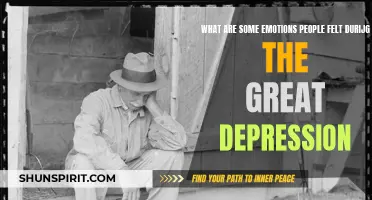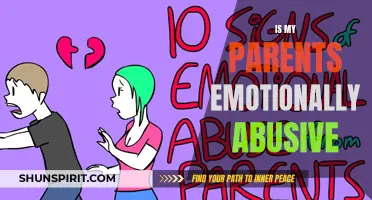
Emotional pain can be deeply distressing and often goes unnoticed by those around us. Just like physical pain, it is crucial to recognize the signs and symptoms of emotional pain in others to extend compassion and support. From subtle changes in behavior to visible signs of struggle, understanding the various indicators can help us identify when someone is going through emotional distress. As we delve into the intricacies of deciphering emotional pain, we can enhance our empathetic capabilities and foster a more compassionate society.
| Characteristics | Values |
|---|---|
| Sadness | High |
| Depression | High |
| Anxiety | High |
| Irritability | High |
| Isolation | High |
| Loss of interest | High |
| Changes in appetite | High |
| Insomnia | High |
| Self-destructive behaviors | High |
| Social withdrawal | High |
What You'll Learn

Physical indicators of emotional pain
Emotional pain can manifest itself in various ways, and it is not always easy to recognize it in others. However, by paying attention to certain physical indicators, you may be able to identify when someone is in emotional pain.
- Facial expressions: Look at a person's face for any signs of distress or sadness. They may have a furrowed brow, clenched jaw, or a downcast expression. It is also common for people in emotional pain to have puffy or red eyes from crying.
- Body language: Pay attention to the person's body language as well. They may appear tense, hunched over, or have their arms crossed tightly against their chest. They may also fidget, pace, or engage in other similar behaviors that indicate uneasiness.
- Changes in appetite and sleep patterns: Emotional pain can affect a person's appetite and sleep. They may either overeat or lose their appetite completely. Similarly, they may struggle with sleeping, experiencing either insomnia or excessive sleepiness. Look for significant weight loss or gain as well as signs of exhaustion.
- Lack of energy: People in emotional pain may lack the energy and motivation to engage in their usual activities. They may appear lethargic or disinterested. You may notice a decrease in their productivity or withdrawal from social interactions and hobbies they once enjoyed.
- Physical ailments: Emotional pain can often manifest itself in physical symptoms. Keep an eye out for frequent headaches, stomachaches, or other unexplained physical pain. Some individuals may even experience a weakened immune system, leading to more frequent illnesses.
- Changes in personal hygiene: When someone is in emotional pain, they may neglect their personal grooming habits. You may notice a decline in their appearance, such as unwashed hair, body odor, or disheveled clothing. This can be indicative of their emotional state.
- Self-destructive behaviors: People in emotional pain may engage in self-destructive behaviors as a way to cope. Look for signs of substance abuse, reckless behavior, or an increase in risky activities. These behaviors are often an attempt to numb or escape from their emotional pain.
It is important to keep in mind that these physical indicators may not be present in every individual experiencing emotional pain, and some subtle signs may be easy to miss. Furthermore, it is crucial to approach the subject with sensitivity and empathy if you suspect someone is in emotional pain. Encourage open communication and offer support, allowing them to share their feelings and seek professional help if needed.
Signs and Solutions: Understanding if You're in an Emotionally Abusive Relationship Book
You may want to see also

Behavioral signs of someone experiencing emotional distress
Emotional distress can take a toll on a person's well-being, affecting their mental, physical, and emotional health. It is important to recognize the signs of emotional distress in others so that we can offer support and help them seek the assistance they may need. Here are some common behavioral signs to look out for:
Changes in appetite and sleep patterns:
People in emotional distress may experience changes in their eating and sleeping habits. They may either lose their appetite and have difficulty sleeping, or they may turn to food and sleep as a way to cope with their distress, leading to overeating and excessive sleeping.
Withdrawal from social activities:
One of the clear signs of emotional distress is when an individual begins to withdraw from activities and engagements they would usually enjoy. They may cancel plans or avoid social gatherings, isolating themselves from friends and family.
Increased irritability and anger:
Emotional distress can often lead to heightened irritability and anger. Small annoyances may trigger outbursts of anger or frustration that are out of character for the individual. They may become easily overwhelmed and have a shorter fuse than usual.
Lack of interest in personal appearance:
Someone in emotional pain may lose interest in maintaining their personal appearance. They may stop grooming themselves, neglect personal hygiene, and stop caring about their physical appearance. This can be a subtle but notable change in behavior.
Changes in mood and emotional instability:
Emotionally distressed individuals may experience frequent mood swings and emotional instability. They may alternate between periods of sadness, anxiety, anger, and numbness. Their emotions may seem intense and unpredictable, creating a sense of imbalance in their overall well-being.
Difficulty concentrating and making decisions:
Emotional distress can affect cognitive function, making it difficult for someone to concentrate or make decisions. They may appear distracted, forgetful, or struggle with simple tasks that they typically handle with ease. This can impact their work performance and overall productivity.
Self-destructive behaviors:
In extreme cases of emotional distress, individuals may engage in self-destructive behaviors. This can include using drugs or alcohol as a coping mechanism, engaging in risky sexual behaviors, self-harm, or suicidal thoughts. Any signs of self-destructive behavior should be taken seriously and addressed immediately.
Remember, it is crucial to approach someone in emotional distress with empathy, compassion, and non-judgment. If you notice these behavioral signs in someone you care about, it is important to offer support and encourage them to seek professional help. Therapy, counseling, or support groups can provide the necessary tools and guidance to cope with emotional distress and lead a healthier, happier life.
Does She Know That She Had an Emotional Affair? Unraveling the Secrets of Emotional Infidelity
You may want to see also

Verbal cues suggesting someone is in emotional pain
Emotional pain is real, and it can be just as debilitating as physical pain. However, unlike physical pain, emotional pain is not always visible or easily recognizable. It often remains hidden behind a strong façade, making it hard to identify and address. As a caring friend or family member, it is essential to be able to recognize the signs of emotional pain in others, so you can provide them with the support they need. Verbal cues can be a valuable tool in identifying emotional pain. By listening carefully and paying attention to what someone is saying, you can gain insight into their emotional well-being. Here are some verbal cues that suggest someone is in emotional pain.
- Negative self-talk: Pay attention to the way the person talks about themselves. If they consistently put themselves down, criticize their abilities, or believe that they are unworthy or incompetent, it could be a sign of deep emotional pain.
- Pessimism: Notice the person's overall outlook on life. Are they constantly focusing on the negative aspects, expecting the worst, or expressing a general sense of hopelessness? This negative mindset can be indicative of emotional pain.
- Expressing emotional numbness: Sometimes, people in emotional pain may describe feeling numb or disconnected from their emotions. They may say things like, "I don't feel anything anymore" or "Nothing seems to matter to me." This detachment from emotions can be a coping mechanism for dealing with deep emotional pain.
- Frequent complaints of physical ailments: Emotional pain often manifests itself physically. People in emotional distress may frequently complain of headaches, stomachaches, or other unexplained physical symptoms. If someone mentions experiencing such symptoms without any medical cause, it could be a sign of underlying emotional pain.
- Chronic fatigue or lack of energy: Emotional pain can drain an individual's energy and leave them feeling constantly exhausted. If someone frequently mentions feeling tired or lacking motivation, it may be an indication of emotional pain.
- Increased irritability or anger: When someone is in emotional pain, it can lead to heightened irritability or anger. They may display a shorter temper, engage in more frequent arguments, or express frustration over minor issues. If someone exhibits uncharacteristic anger or irritability, it could be a red flag for emotional pain.
- Social withdrawal: People experiencing emotional pain often isolate themselves from others. They may decline invitations to social events, avoid making plans, or express a general disinterest in maintaining relationships. If someone starts withdrawing from social interactions, it may be a cry for help.
- Expressing thoughts of self-harm or suicide: One of the most crucial verbal cues indicating emotional pain is when someone speaks about self-harm or suicide. They may make direct or indirect statements about wanting to end their life or harm themselves. It is vital to take any mention of self-harm or suicide seriously and seek immediate help to ensure their safety.
When observing these verbal cues, it is essential to approach the person with empathy and without judgment. Let them know that you are there to listen and support them. Encourage them to seek professional help, such as therapy or counseling, to address their emotional pain. Remember that you cannot single-handedly solve someone's emotional pain, but your support and understanding can make a significant difference in their journey towards healing.
The Importance of Emotional Intelligence in Management: A Compelling Case Study
You may want to see also

Understanding emotional pain through social withdrawal
Emotional pain is an intrinsic part of the human experience. Just like physical pain, emotional pain can be difficult to identify and even more challenging to communicate. It can manifest in various ways, one of which is through social withdrawal.
Social withdrawal is characterized by a decrease in social interaction and a reluctance to engage with others. It is often a telltale sign that someone is in emotional pain. If you suspect that a loved one or acquaintance is suffering, it is essential to understand the reasons behind their withdrawal and to offer support and understanding.
Here are some key insights into understanding emotional pain through social withdrawal:
- Emotional Pain Triggers Withdrawal: Emotional pain can stem from a variety of sources, such as trauma, loss, rejection, or chronic stress. When individuals experience intense emotional pain, they often isolate themselves as a way to protect themselves from further hurt or vulnerability. Withdrawal can also be a defense mechanism to avoid burdening others with their emotions.
- Changes in Behavior and Routine: If someone who was previously outgoing and sociable suddenly becomes distant and avoids social situations, it could indicate emotional pain. Look for changes in their behavior, such as canceling plans, declining invitations, or distancing themselves from friends and family. Disruption in their daily routine or the loss of interest in activities they once enjoyed are additional red flags.
- Observable Physical and Emotional Signs: Emotional pain can manifest physically as well as emotionally. Physical signs can include changes in appetite, sleep disturbances, fatigue, or visible signs of distress like tearfulness or red eyes. Emotionally, individuals in emotional pain may express hopelessness, sadness, irritability, or a general disinterest in life.
- Lack of Self-Care: Another indicator of emotional pain is neglecting personal care and hygiene. Individuals may appear disheveled, have a decline in grooming habits, or display a lack of interest in their appearance. This neglect is often a reflection of the internal turmoil they are experiencing.
- Communication Difficulties: People in emotional pain may have difficulty articulating their emotions and expressing their needs. They may feel embarrassed or ashamed of their pain and believe that others won't understand or empathize. Additionally, they may fear judgment or rejection if they reveal their true emotions. Consequently, they may withdraw even further, making communication challenging.
How to Offer Support:
- Create a Safe and Judgement-Free Zone: It is crucial to create an environment where individuals feel safe to open up about their emotions without fear of criticism or judgment. Make it clear that you are there to support them and that their feelings are valid.
- Listen with Empathy: Practice active listening and validate their emotions. Reflect their feelings back to them to let them know that you understand and empathize with their pain. Avoid offering unsolicited advice or belittling their experiences.
- Encourage Professional Help: While offering support is important, it is equally essential to encourage individuals in emotional pain to seek professional help. Suggest therapy or counseling as a means to explore and address their pain in a safe and confidential setting.
- Offer Distractions: Engaging in pleasurable activities and hobbies can help alleviate emotional pain. Encourage the individual to participate in activities they used to enjoy or introduce them to new interests. Distractions can provide temporary relief and contribute to their overall well-being.
Remember, understanding emotional pain and helping someone through their withdrawal requires patience, empathy, and non-judgment. It is crucial to respect their boundaries, provide support when needed, and encourage professional help when necessary. Together, we can create a more compassionate and understanding society.
When False Accusations Become Emotional Abuse: The Power of Manipulation and Gaslighting
You may want to see also
Frequently asked questions
There are various signs that can indicate someone is in emotional pain. These signs include sudden changes in behavior, withdrawal from social activities, a persistent sad or negative mood, changes in appetite or sleep patterns, and a loss of interest in previously enjoyed activities.
Physical signs of emotional pain can manifest as headaches, digestive issues, muscle tension or aches, changes in appetite or sleep patterns, and a weakened immune system. It's important to note that these physical symptoms can also be due to other factors, so it's essential to consider the context and any other observable signs.
Yes, emotional pain can manifest as physical pain. Research has shown that emotional distress can negatively impact the body, leading to symptoms such as headaches, increased muscle tension, and even chronic pain conditions. The mind-body connection is a complex one, and emotional well-being can significantly impact physical health.
To support someone in emotional pain, it's important to be a good listener and offer empathy and understanding. Show them that you are there for them, and encourage them to seek professional help if needed. It's also crucial to respect their boundaries and provide ongoing support, as emotional pain can take time to heal.
If someone's emotional pain is significantly impacting their daily life, relationships, or overall well-being, it may be necessary to encourage them to seek professional help. Signs that professional help may be needed include thoughts of self-harm or suicide, persistent feelings of hopelessness or despair, or if their emotional pain is interfering with their ability to function. Encouraging them to seek help from a mental health professional can provide them with the necessary support and resources they may need.







